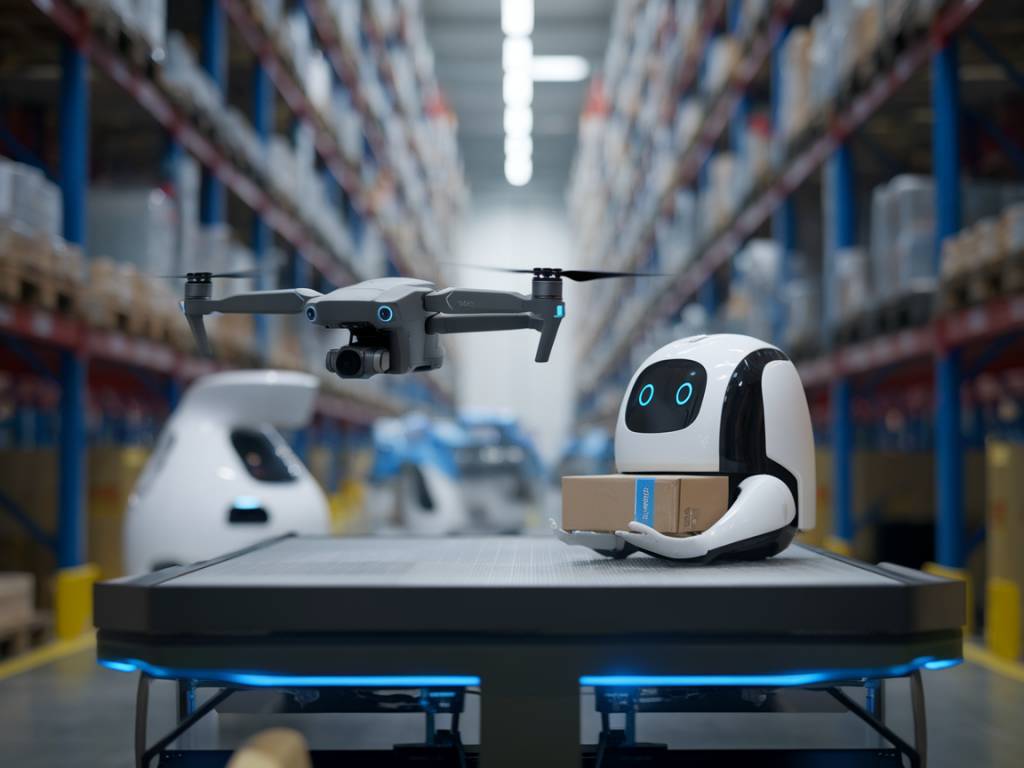The Current Landscape of Last-Mile Delivery
Last-mile delivery is a crucial aspect of the logistics and supply chain industry, responsible for the final step of the delivery process where the product reaches the customer. This phase is often the most expensive and challenging part, significantly impacting customer satisfaction and overall delivery efficiency. Traditionally managed through conventional parcel delivery systems, the last-mile segment has seen noteworthy advancements driven by technological innovations.
Given the growing consumer demand for quicker, more efficient delivery options, logistics companies are investing heavily in technologies like drones and autonomous robots. These innovations promise to reshape the last-mile delivery landscape, aiming to bring down operational costs and enhance efficiency.
The Rise of Drone Delivery Systems
Drones, or Unmanned Aerial Vehicles (UAVs), have garnered significant attention in the realm of last-mile delivery. Companies such as Amazon, UPS, and Google’s Wing have been at the forefront, conducting trials and launching pilot programs across various regions.
The primary advantages of using drones for last-mile deliveries include:
- Speed: Drones can bypass road traffic, leading to faster delivery times.
- Cost-Efficiency: Operational costs can be reduced as drones require fewer human resources and can deliver multiple packages in a single flight.
- Environmentally Friendly: Electric-powered drones produce lower emissions compared to traditional delivery vehicles.
However, challenges such as regulatory compliance, battery life limitations, payload capacity, and airspace management remain. Regulatory bodies worldwide, including the Federal Aviation Administration (FAA) in the United States, are working on frameworks to ensure safe and efficient drone operations.
Autonomous Robots: The Ground Perspective
Parallel to drone advancements, autonomous ground robots are revolutionizing the last-mile delivery sector. Companies like Starship Technologies, Nuro, and Kiwibot have introduced autonomous delivery robots that navigate sidewalks, pedestrian pathways, and streets to deliver parcels directly to customers’ doorsteps.
The key benefits of autonomous robots include:
- 24/7 Operations: Robots can operate around the clock, enhancing delivery flexibility and availability.
- Safety: Equipped with advanced sensors and AI, these robots can navigate complex urban environments while avoiding obstacles and ensuring pedestrian safety.
- Cost Savings: Reduced reliance on human drivers and increased efficiency in deliveries can lead to substantial cost savings.
Hurdles such as ensuring reliable navigation in diverse weather conditions, public acceptance, theft prevention, and developing sophisticated algorithms for efficient route planning persist. Nonetheless, the investment in and development of autonomous robots are on the rise, with significant potential for overcoming these obstacles.
Integrating Drones and Autonomous Robots into Existing Systems
The success of drones and autonomous robots in last-mile delivery depends on their seamless integration into existing logistics networks. Compatibility with current warehouse management systems, inventory databases, and customer service protocols is essential. Here are some strategies that could facilitate this integration:
- Hybrid Delivery Models: Combining traditional delivery methods with drones and robots to cover different delivery zones effectively.
- Data Synchronization: Ensuring real-time synchronization between autonomous systems and central databases for accurate tracking and inventory management.
- Infrastructure Adaptations: Developing landing pads for drones and charging stations for autonomous robots to maintain operational efficiency.
The Economic Impact
The adoption of drones and autonomous robots is poised to have significant economic implications for businesses and the broader economy. Key economic impacts include:
- Reduced Labor Costs: By minimizing human involvement in the delivery process, companies can lower labor costs, reallocating resources to other critical areas.
- Scalability: Automated systems can easily scale operations to meet demand surges, such as during peak shopping seasons.
- Investment in Technology: Increased investments in robotics and drone technology can spur economic growth and innovation in the tech sector.
Additionally, governments’ role in supporting these innovations through subsidies, grants, or favorable policies can further accelerate economic benefits.
Sustainability and Environmental Considerations
Increasing attention to environmental sustainability is influencing the logistics industry’s shift toward cleaner and more efficient delivery methods. Drones and autonomous robots, primarily powered by electricity, offer greener alternatives to traditional gasoline or diesel-powered vehicles. Key environmental advantages include:
- Reduced Carbon Footprint: Lower emissions contribute to cleaner air and reduced global warming impacts.
- Efficient Energy Use: Advanced battery technologies and energy-efficient systems enhance operational sustainability.
- Minimized Congestion: Fewer delivery trucks on the road can reduce traffic congestion and associated emissions.
Case Studies: Pioneering Initiatives
Several companies have successfully integrated drones and autonomous robots into their last-mile delivery operations, serving as case studies for the potential and challenges of these technologies.
Amazon Prime Air: Amazon’s drone delivery program aims to deliver packages within 30 minutes. Their continuous R&D efforts are focused on improving safety features, flight stability, and regulatory compliance.
Starship Technologies: Starship Technologies has deployed autonomous delivery robots across various cities and university campuses. Their robots have completed thousands of deliveries, showcasing the potential for scalable and reliable operations.
Nuro: Nuro’s autonomous delivery vehicles have been operational in partnerships with companies like Kroger and Domino’s. These vehicles are designed to carry goods rather than passengers, optimizing space and safety for deliveries.
Future Prospects and Innovations
The future of last-mile delivery with drones and autonomous robots is teeming with possibilities. Innovations in artificial intelligence, machine learning, and IoT (Internet of Things) are set to enhance the capabilities of these delivery systems. Key future trends include:
- Advanced AI Algorithms: Improved navigation, obstacle detection, and route optimization will make autonomous delivery systems more efficient.
- Enhanced Battery Technologies: Longer battery life and faster charging times will extend operational hours and reduce downtime.
- 3D Printing: On-site 3D printing in conjunction with autonomous delivery could shorten the supply chain even further.
Moreover, collaborations between tech companies, logistics firms, and regulatory bodies will be vital in overcoming existing barriers and unlocking the full potential of these disruptive technologies.
The evolution of last-mile delivery through drones and autonomous robots represents a paradigm shift poised to revolutionize the logistics industry. As technological advancements continue to address current challenges, the widespread adoption of these innovative delivery methods will redefine efficiency, cost-effectiveness, and sustainability in last-mile logistics.

